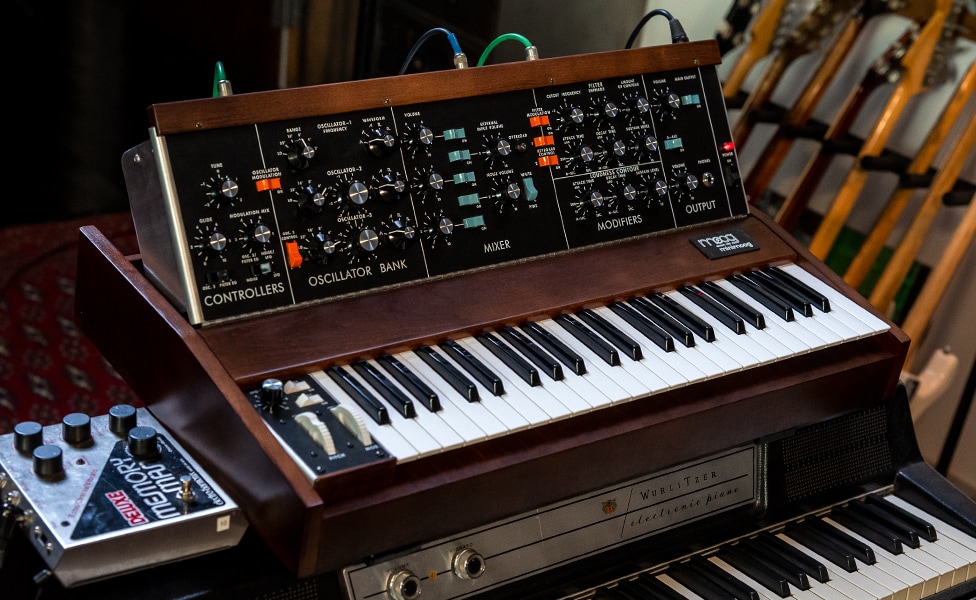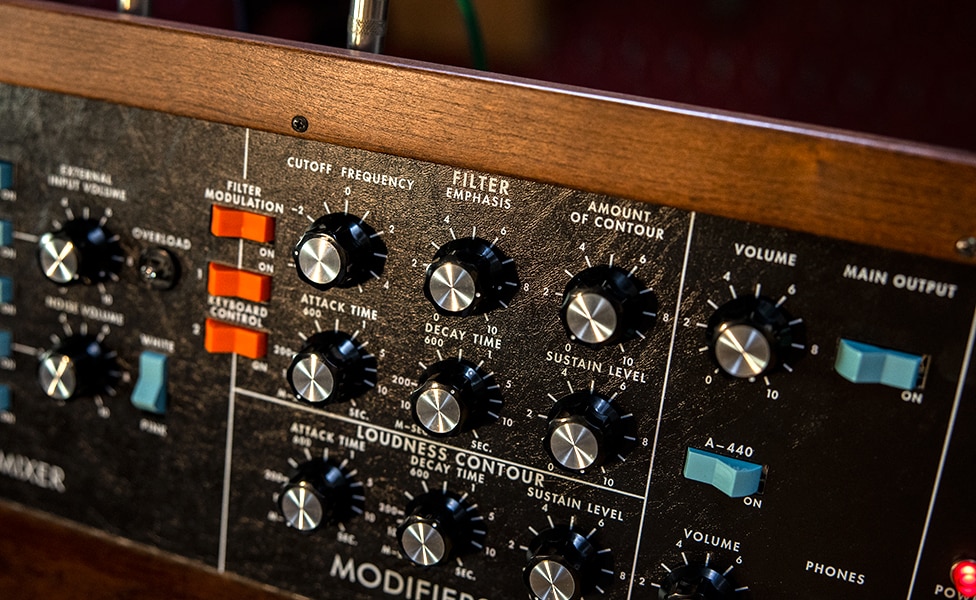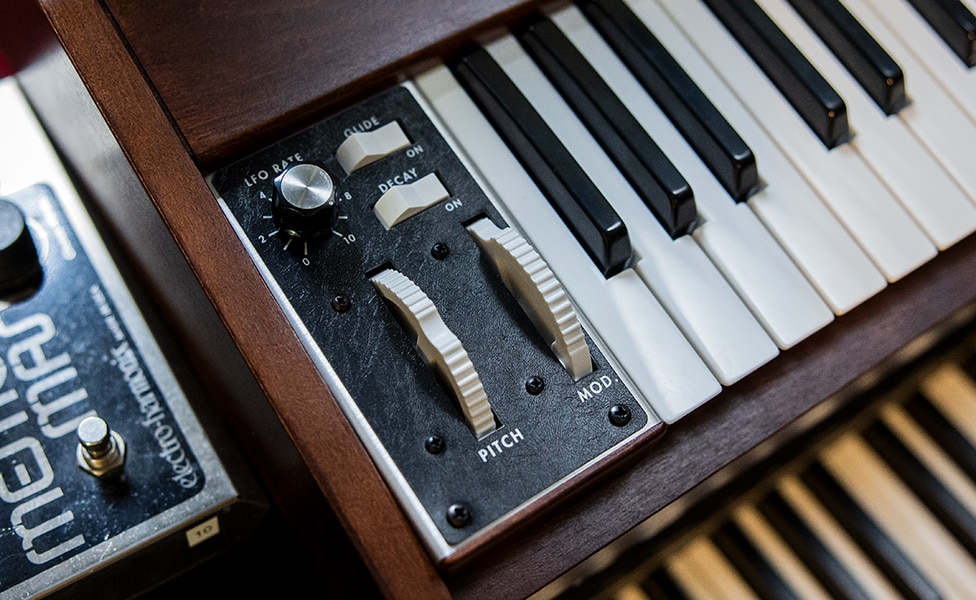Having earned a slew of celebrated devotees the likes of Kraftwerk, Stevie Wonder, Pink Floyd, Herbie Hancock, Parliament-Funkadelic, Devo, Dr. Dre, Carl Craig, J Dilla, Mike Dean, Portishead and Trent Reznor, the Minimoog Model D synthesizer has shaped the sounds of genres and generations past and present. And while it harkens a myriad of beloved retro vibes like nothing else can, its endless analog sonic palette makes it perennially futuristic. As Mikael Jorgensen of Wilco recalls from his childhood in a Guitar Center-exclusive interview and demo (below), “My world changed with the stroke of a key and the twist of the knob, and I was completely and utterly possessed. This thing could make sounds that were impossible to describe.”
A timeless piece of musicmaking engineering, the Minimoog was the first portable synthesizer commercially available upon its introduction in 1970, and it returns as one of the most preeminent, relevant synths today. After a prolonged production hiatus since its previous 2016 release, the 2022 reissue of the legendary Model D brings back all the glory of its legacy—and then some. On the revamped model, Jorgensen raves, “The reissue has some exciting outputs—aftertouch and velocity—that you can then patch back in to filter frequency, or the pitch of the oscillator or the modulation source. Just those few additions really open it up in a way that’s pretty exciting.” Perhaps more importantly, he adds, “It sounds incredible on its own.”
We sat down with Steve Dunnington, vice president of product development at Moog Music Inc., and a longtime authority on Moog’s product design and hardware engineering. He gave us the lowdown on what inspired its rebirth, and some highlights of what’s made—and continues to make—the Minimoog Model D synth a mainstay.
Steve, could you tell us a little bit about your background at Moog and what you do there?
Steve Dunnington: I have been at Moog Music since 1994 when it was called Big Briar Inc., and there were five employees—including Bob Moog himself. I’ve worn many hats over the years. Now, I am called “VP of product development,” and lead a group of engineers and product developers who help bring you the amazing products that we make. As a product designer and hardware engineer, I was involved in many of the products we still make today, and some that we no longer make. Some of my favorites over the years have included the FreqBox, Minitaur, Sub37, DFAM and Subharmonicon—but I love them all. The present team that brought the Model D to fruition worked tirelessly to get if finished, and I am honored to get to collaborate with such talented and passionate folks.
The Minimoog was last reissued in 2016, before production was ceased in 2017 due to scarcity of parts. Can you tell us about the efforts to bring it back into production?
Today, a scarcity of parts is part of the normal order of doing business in the electronics business. We’ve had to become good at sourcing difficult-to-find parts. It started with the question, “What would it take to reissue the Minimoog Model D again—is it possible?” We did some research on parts sourcing. In the process, we found sources for the parts that were difficult to obtain in 2017. That was one of the elements that encouraged us to pursue the opportunity to make the Model D available worldwide again.

What are some of the most classic examples of the Minimoog sound?
The ones that come to my mind first are classics like Rick Wakeman’s synth work with Yes on the album Fragile, Bernie Worrell’s work with Parliament, especially the song “Flashlight,” Kraftwerk’s “Autobahn,” Devo’s “Whip It,” or Jan Hammer with the Mahavishnu Orchestra—but also artists such as Tycho, Olaf Hilgenfeld (of Skinnerbox), Lisa Bella Donna, Adrian Utley and Will Gregory.
One of the key ingredients in the Minimoog Model D is the famed Ladder filter. What makes that filter design so special?
There are several remarkable things about the Moog Ladder filter design, but the sound that it makes is what captures musicians’ imaginations the most. One of the things that makes it special is that its character changes with the amount of signal that it is driven with. As it is driven hard, the distortion that is generated is not harsh, but quite warm and musically pleasing. It’s not hard distortion or overdrive, but it just makes simple waveforms sound quite good.

How does the envelope design impact the sound of the Model D? How did that design set it apart from other contemporary synths of the ’70s?
The envelopes are a part of not only the sonic characteristics of the Minimoog Model D, but also the playing technique in skilled hands. When set to percussive attacks, the Minimoog envelopes are fast, but also have a unique shape that adds to the punch and impact of the sound. Our artist friend and colleague Lisa Bella Donna pointed out another feature that is special. With a dialed-in fast attack and long release, triggering the envelopes again during the release stage can cause the envelope to reach an even higher peak than by triggering it only once. The effect is cumulative, so, by doing this in quick succession, the maximum envelope level gets higher and higher. In terms of expressivity, this adds an intensity to fast runs as the filter opens more and more as one plays more quickly, allowing for more bite and harmonics.
The new Minimoog differs from the original run in a number of ways. What are the most meaningful changes on this reissue?
The largest difference is probably around the pitch wheel. We have converted the pitch wheel to a spring-loaded design, which enables automatic return to zero for the pitch wheel, which was not part of the original Minimoog design. Pitch Bend wheel-playing technique has evolved since the 1970s, and the vast majority of keyboard players now are relying on the return to zero for their technique. I think most modern keyboard players will find the addition of the spring-loaded pitch wheel a welcome change. The instrument remains as responsive to a player’s technique as ever.
In addition, we have adapted the Mod Wheel controller to send MIDI CC1, which makes the new Model D more effective with MIDI control.

Outside of what you just mentioned with the Mod Wheel, what level of MIDI implementation is offered with the new Model D?
Only the aftertouch-equipped keyboard and the control wheels are equipped to send MIDI, and the Minimoog receives MIDI CC1 and MIDI Pitch Bend messages as well as MIDI Note On messages. It’s a basic implementation, but can be put to very effective use—as seen in the video of Will Gregory’s Moog Ensemble piece, “Archimedes Screw.”
Introduced 50-plus years ago and immediately revolutionizing the world of music, the Minimoog offers a sound and playing experience that’s never gone out of style. Why do you think that is?
I think it boils down to instrument design. The Minimoog contains enough complexity to offer endless possibilities, yet is limited and approachable enough that great results can be achieved by a keyboardist or musician—with minimal experience with synthesizer sound design. It inspires music to flow from the musician, through the instrument to the sound system it uses. It sounds fantastic both to the musicians and their audiences. The sound of the instrument is malleable for a large variety of moods and expressions, and both exploration and imagination reward the musician who uses it for their music.





